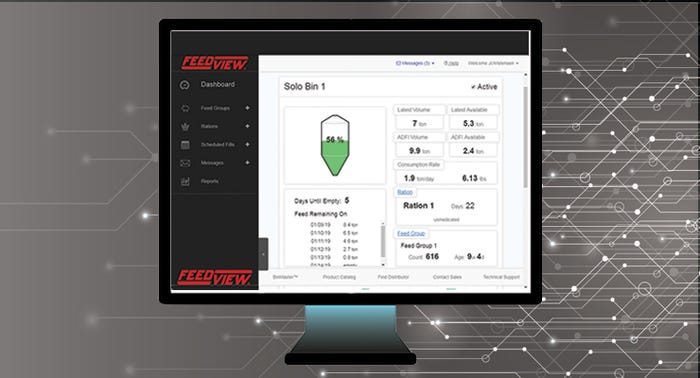Sensors and software to simplify feed inventory
FeedView is a comprehensive feed management solution that combines wireless, battery-powered laser level sensors with a cloud-based, simple-to-use software.
January 15, 2019

Imagine eliminating climbing bins, relying on guesswork, massive spreadsheets and piles of paperwork. Instead, a user could simply view feed inventory information on his or her phone, tabletc or computer. FeedView is a comprehensive feed management solution that combines wireless, battery-powered laser level sensors with a cloud-based, simple-to-use software. It automatically measure bin levels, projects consumption using historical consumption rates, records the use of medicated feeds and knows when to schedule deliveries … anywhere, anytime.
To develop FeedView, BinMaster worked directly with livestock producers to determine specific needs for monitoring feed storage, consumption and delivery along with the reporting needed to make their job easier. The solution needed to be affordable and completely scalable from a single-barn to national producers. The software was designed for managing feed at poultry hatcheries, layer, or broiler operations or from the nursery, to farrowing and finishing for hog farmers.

Farmers demanded a sensible sensor.
The battery-powered FVL-100 level sensor eliminates the expense of wiring and simplifies setup, addressing the installation and investment concerns of hog and poultry feeding operations. It installs easily using an adjustable swivel mount or fixed angle mounting plate. Powered by a lithium battery, the sensor measures livestock feed in silos up to 35 feet tall. It takes interval readings once per hour with a battery life of three to five years. LoRa long range communications send measurements to the FeedView web application for easy access from a phone, tablet or desktop PC.
Software needed to be intuitive and easy-to-use.
Managing FeedView starts with identifying farms, barns, feed groups and feed rations. Detailed information about feeds, medications (for Veterinary Feed Directive) and feed groups are tracked in the system and saved over time for auditing.
FeedView users can be set as administrative or viewer roles for secure control over the system. Each user can customize their views, arranging dashboard columns as they prefer. Feed delivery companies or corporate headquarters can also be given access to data if desired. This can eliminate spreadsheets, emails and phone calls regarding inventory or delivery status.

Never run out of feed again.
Feed groups are established based on the feed bins from which they’re feeding. Each feed group can be tracked throughout their processing cycle. Users can update a feed group’s status to account for headcount changes due to events like death-loss or sent to market. Status updates made during the feed group’s processing cycle are stored and can be reviewed at any time. Using the feed group’s status and average daily feed intake information, the feed group’s consumption rate is predicted and used to calculate when bins will run out of feed.
Users can create new rations, assign rations to specific feed bins and track whether that ration was medicated (including VFD numbers and expiration dates). The rations dashboard shows which ration is currently stored in each bin. Historical records allow the user to review when specific rations were used, which bins they were assigned to and what medications were used.
Chart and table reports can be easily created for the current status or a specified historical reporting period. A unique chart showing sensor level readings converted to tons overlays the ADFI slope indicating consumption and filling for a specified date range.
Running a successful poultry or hog operation is a challenge. Margins are tight, feed is expensive and proper documentation is crucial. Centralizing the monitoring and management of “all things feed” can help streamline operations, eliminate guesswork and optimize ordering and delivery schedules.
About the Author(s)
You May Also Like



